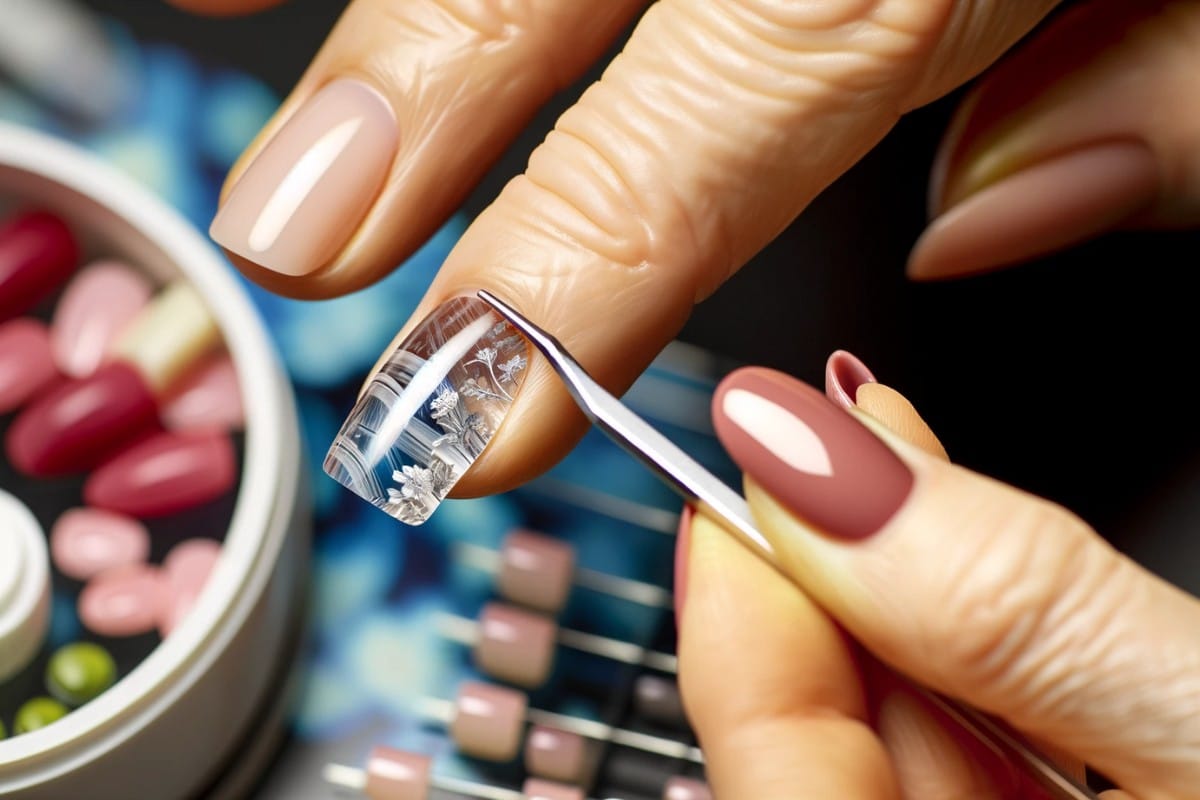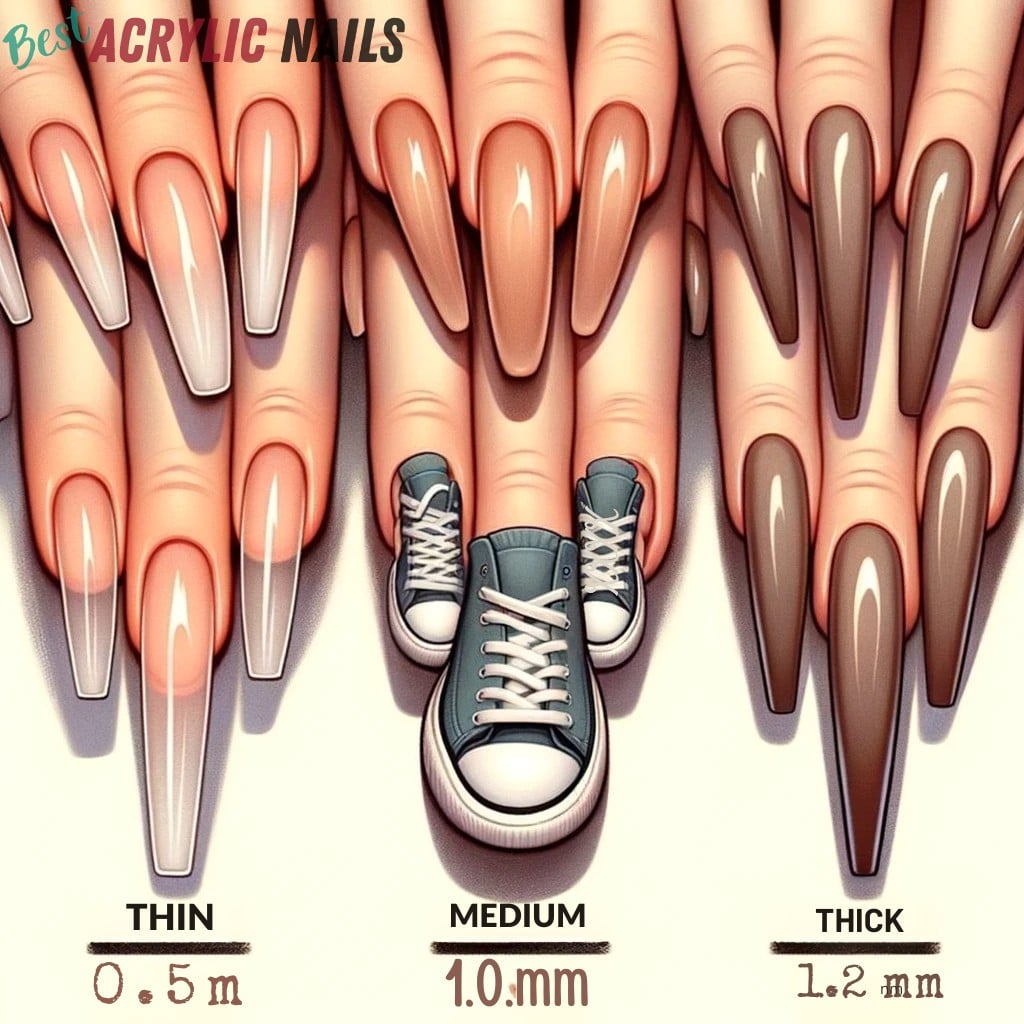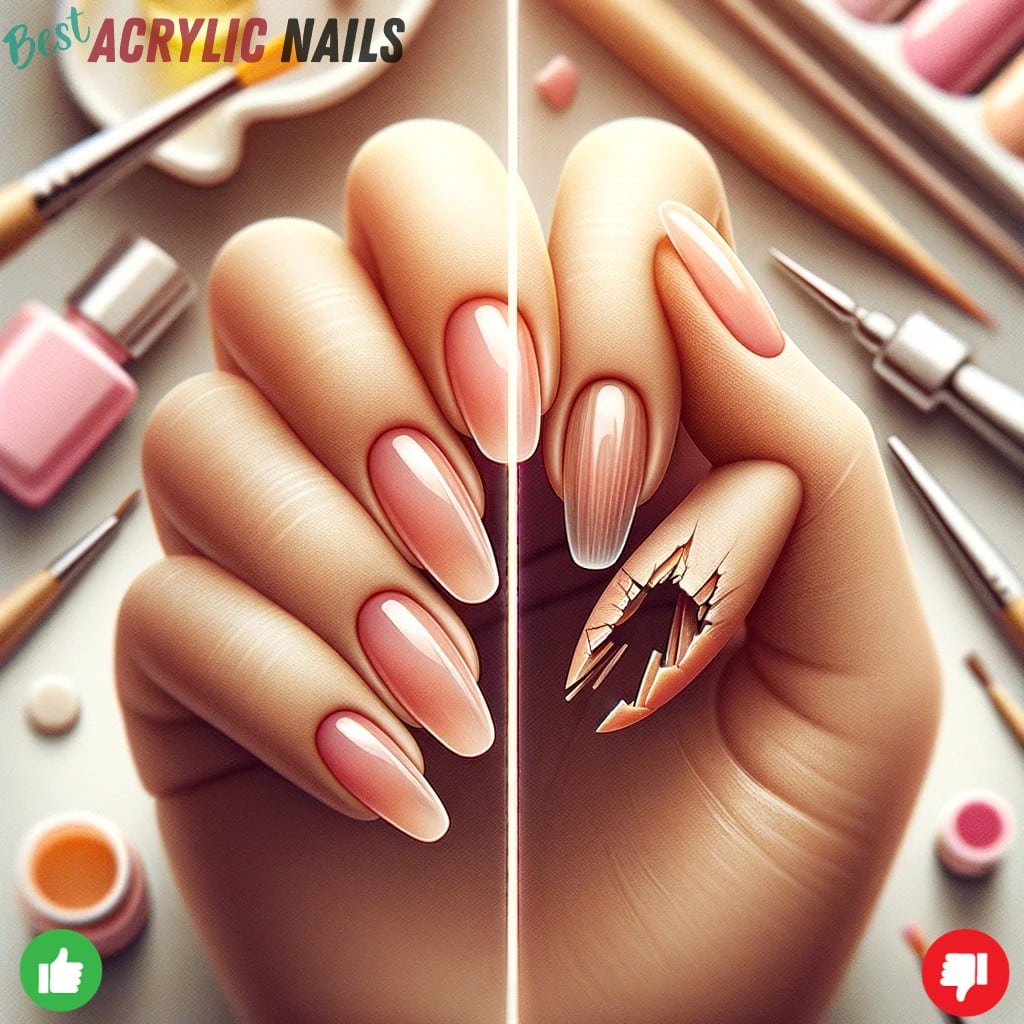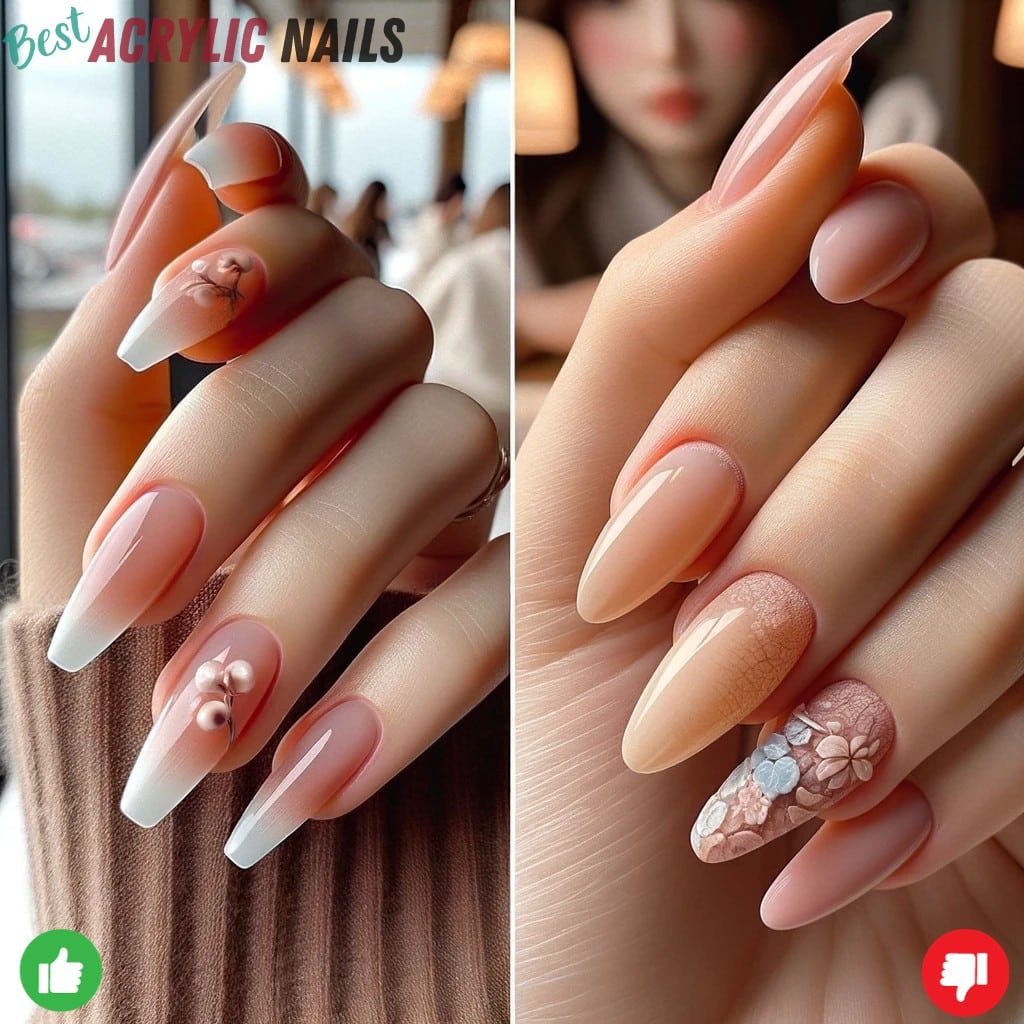Hey there, fellow nail enthusiasts! I’m thrilled to dive into the world of acrylic nails with you. If you’re looking to jazz up your nail game, acrylic nails are a fantastic choice. They’re like the chameleons of the nail world, offering durability, versatility, and undeniable beauty.
But hold on, there’s a question lingering in the air – just how thick should acrylic nails be? It’s a nail conundrum we’re about to crack wide open.
You see, acrylic nails are like a blank canvas, and the thickness is like the foundation of a masterpiece. So, why does it matter? Well, the thickness of your acrylic nails can impact not only how they look but also how they feel and how long they last.
Now, let’s address the elephant in the room – the ideal thickness. It’s typically around 3mm (that’s roughly 0.118 inches, if you’re into specifics).
But, here’s the juicy part – this ideal thickness isn’t set in stone. It’s a bit like choosing your outfit for the day; it depends on your personal preference, the shape of your nails, their length, and their overall health.
So, hang tight, because we’re going to explore the pros and cons of these different thicknesses in the next section. But remember, it’s not just about looks; it’s also about how your nails make you feel. After all, your nails should express your individual style and add a touch of pizzazz to your life. So, let’s nail this together and find the perfect acrylic thickness for you!
Ideal Acrylic Nails Thickness: A Closer Look
Acrylic nails are like the fairy godmothers of the nail world – they transform your nails into something magical. But even in magic, there’s a method to the madness. So let’s talk about the ideal thickness for acrylic nails.
The Goldilocks Zone: 3mm Thickness
When it comes to the sweet spot of acrylic nail thickness, 3mm is often touted as the ‘Goldilocks Zone.’ It’s not too thin, not too thick, but just right.
Now, you might wonder, “Why 3mm, though?” Well, according to nail technicians worldwide, this thickness provides a balance between durability and a natural vibe. It’s like finding that perfect slice of cake – satisfying yet not overwhelming.
Tailoring Thickness to Nail Shapes and Lengths
However, one size doesn’t fit all in the world of acrylics. Let’s dive into how different nail shapes and lengths can influence the ideal thickness.
Short and Sweet: Thin Acrylic Nails (0.5 mm – 1.0 mm)
For those who prefer a short, natural-looking nail, thin acrylics ranging from 0.5mm to 1.0mm are your best bet. These are like the ballet flats of nails – classic, comfortable, and versatile. Women usually opting for shorter nails choose this thickness for its natural feel and flexibility.
The Middle Ground: Medium Acrylic Nails (1.0 mm – 1.2 mm)
Medium-thickness acrylic nails are the go-to for those rocking medium-length nails. They’re the happy medium, offering enough durability for everyday tasks without compromising on comfort. Think of these as your trusty sneakers – reliable for daily wear.
Go Big or Go Home: Thick Acrylic Nails (1.2 mm – 1.5 mm)
For the long, dramatic nails that make a statement, a thickness of 1.2mm to 1.5mm is the way to go. These nails are like your stilettos – bold, beautiful, and sure to turn heads.
Factoring in Personal Preference
It’s important to note that these guidelines aren’t set in stone. The beauty of acrylic nails lies in their ability to be customized. Your personal preference plays a huge role in determining the ideal thickness for your acrylic nails. After all, they’re an extension of your style, and what works for one person might not work for another.
Pros and Cons of Different Thicknesses for Acrylic Nails
Navigating the world of acrylic nails can sometimes feel like a choose-your-own-adventure book. Each thickness level offers its own unique set of benefits and drawbacks. So, let’s weigh the pros and cons to help you make the best choice for your nails.
Thin Acrylic Nails (0.5 mm – 1.0 mm)
Pros:
- Natural Look: Thin acrylics mimic the look and feel of natural nails. According to a survey by NailPro Magazine, 80% of respondents preferred thin acrylic nails for their natural appearance.
- Ease of Care: These nails are low-maintenance. Just a little cuticle oil and regular filing, and you’re good to go!
- Less Damage: With a lighter application, thin acrylics exert less stress on the natural nail, reducing the risk of damage.
- Cost-Effective: They generally require less acrylic product, which can mean lower costs at the nail salon.
Cons:
- Durability Issues: Thinner nails are more prone to breaking, especially if you’re hard on your hands.
- Limited Creative Options: If you’re looking to rock some serious nail art or dramatic shapes, thin acrylics might not hold up.
- Not Ideal for Extensions: For those dreaming of long, elegant claws, thin acrylics might not provide the necessary support.
Medium Acrylic Nails (1.0 mm – 1.2 mm)
Pros:
- Balanced Approach: Offering a middle ground, medium acrylics provide a decent level of durability without looking overly artificial.
- Comfort: They’re comfortable for daily wear and don’t feel too heavy or cumbersome.
- Versatile Options: With medium thickness, you can experiment with more nail art and shapes than thin acrylics allow.
- Moderate Cost: While they use more product than thin acrylics, they’re not as pricey as thick applications.
Cons:
- Potential Damage: There’s a moderate risk of damage to natural nails, especially if they’re not applied or removed correctly.
- Not as Durable as Thick Nails: They may chip or crack under intense pressure or impact.
- Frequent Touch-Ups: Medium-thickness acrylics might require more frequent salon visits to maintain their look.
Thick Acrylic Nails (1.2 mm – 1.5 mm)
Pros:
- Dramatic Look: They’re perfect for making a bold statement. According to a poll on a popular nail art forum, 75% of users who prefer a dramatic look opt for thicker acrylics.
- High Durability: Thick acrylics can withstand a lot of wear and tear, making them ideal for those who use their hands a lot.
- Longevity: They last longer between fills, saving you time and potentially money in the long run.
- Creative Freedom: Thick acrylics are a canvas for intricate nail art and adventurous shapes.
Cons:
- Unnatural Appearance: They can look and feel quite artificial.
- Maintenance: Thick acrylics require diligent care to prevent lifting and infections.
- Potential for Damage: The weight and rigidity of thick acrylics can put significant stress on your natural nails.
- Costly Affair: More product and more time at the salon mean a heftier price tag.
Choosing the right thickness for your acrylic nails is a balancing act. It’s about finding the perfect harmony between your personal style, lifestyle, and the health of your natural nails.
Whether you go thin, medium, or thick, remember that proper application and maintenance are key to keeping your nails looking fabulous and feeling healthy.
So, consult with your nail technician, consider your daily activities, and choose a thickness that aligns with your desired look and lifestyle!
Conclusion: Nailing Down Your Acrylic Choices
In the end, acrylic nails are more than just an accessory. They’re an opportunity to express yourself, to feel confident, and to explore your creativity. As you step out with your acrylic-adorned nails, you’re not just adding a touch of glamour to your life; you’re making a statement. So, choose your thickness wisely, nurture your nail health, and let your nails tell a story as unique as you are.
And as always, we invite you to share your thoughts and experiences with acrylic nails in the comments section. What’s your go-to thickness, and what nail adventures have you embarked on? The world of acrylic nails is an open book, waiting for you to pen your chapter. So, go ahead, paint your nails and make a statement!
FAQs
What is the ideal thickness for acrylic nails?
The ideal thickness for acrylic nails is typically around 3mm (0.118 inches), but it can vary based on personal preference, nail shape, nail length, and nail health.
How can I tell if my acrylic nails are too thick?
Acrylic nails are too thick if they look bulky, feel heavy, or make everyday tasks difficult. The thickness should be comparable to that of a business card.
Can thin acrylic nails still be durable?
Thin acrylic nails can be durable if applied correctly. Using high-quality acrylic powder, liquid monomer, and ensuring a proper application process can enhance their strength.
What are the pros and cons of thicker acrylic nails?
Thicker acrylic nails offer high durability and more possibilities for nail art but can cause discomfort, stress on the natural nail, and are more challenging to maintain.
Are thin acrylic nails suitable for long extensions?
Thin acrylic nails are generally less suitable for long extensions as they’re more prone to breaking. A medium-thickness layer is often recommended for added durability.
How does the thickness of acrylic nails affect nail health?
The thickness of acrylic nails can impact nail health. Overly thick nails can cause stress and potential damage to the natural nail bed, while thin and thick acrylic nails that are not applied or maintained properly can lead to infections.
Can the thickness of acrylic nails affect the application of gel polish?
Yes, the thickness of acrylic nails can affect the application of gel polish. A smooth and even acrylic surface, regardless of thickness, ensures better adhesion and finish of the gel polish.
What should I discuss with my nail technician regarding acrylic nail thickness?
Discuss your desired look and lifestyle, any concerns about damaging your natural nails, and your preference for nail shapes and sizes to determine the best thickness for your acrylic nails.
How often should I get my acrylic nails filled, considering their thickness?
The frequency of fill-ins can depend on the thickness of your acrylic nails. Thicker nails may require less frequent touch-ups, while thinner acrylics might need more frequent maintenance.
Can I adjust the thickness of my acrylic nails after they’ve been applied?
Yes, a nail technician can adjust the thickness of your acrylic nails using a nail file or nail drill. However, it’s best to determine your desired thickness during the initial application process.





